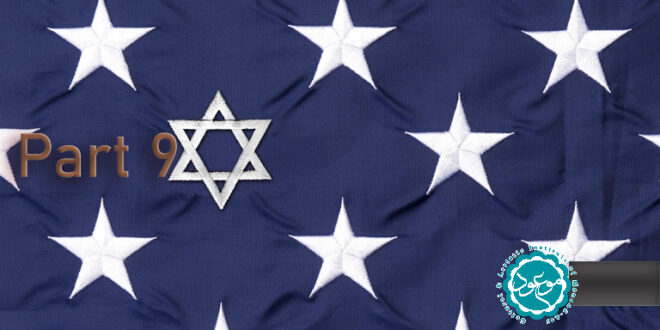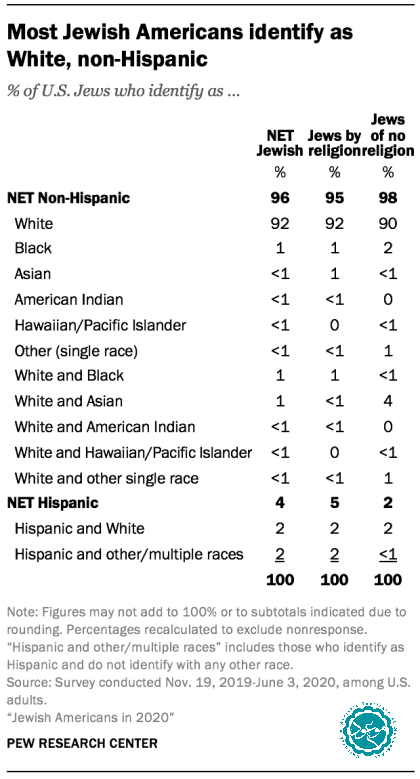According to Mouood, quoting by pewresearch:
9. Race, ethnicity, heritage and immigration among U.S. Jews
The majority of U.S. Jews identify as White. But in recent years, journalists, scholars and Jewish community leaders have wondered about the percentage of U.S. Jews who are “Jews of color,” “people of color” or “BIPOC” (an acronym for Black, Indigenous and people of color), and who should be included in these groups.33 The new Pew Research Center survey did not contain questions using those terms, and therefore cannot determine how many U.S. Jews consider themselves to be people of color. However, the survey included several other questions that can be used to explore the overlapping connections between race, ethnicity, heritage and geographic origin among Jewish Americans.
The current survey, like most Center surveys in the United States, measures race and ethnicity using categories that mirror the way the U.S. Census Bureau asks about these identities, which is necessary for statistical reasons in order to ensure that surveys are representative of U.S. adults overall.34 When given these choices, 92% of U.S. Jews describe themselves as White and non-Hispanic, while 8% say they belong to another racial or ethnic group. This includes 1% who identify as Black and non-Hispanic; 4% who identify as Hispanic; and 3% who identify with another race or ethnicity – such as Asian, American Indian or Hawaiian/Pacific Islander – or with more than one race.

The survey also asked respondents about their Jewish heritage: whether they are Askhenazi (which the survey defined as following the Jewish customs of Central and Eastern Europe), Sephardic (following the Jewish customs of Spain) or Mizrahi (following the Jewish customs of the Middle East and North Africa).35
Two-thirds of U.S. Jews say they are Ashkenazi; 3% describe themselves as Sephardic and 1% as Mizrahi, although an additional 6% identify with some mixture of these or other categories. (However, some of the 6% identify with unclear categories or do not specify their mixture. A total of 7% of the Jewish adults in the survey clearly identify as Sephardic or Mizrahi, either alone or in combination with other categories.) In addition, 17% say these labels either do not apply to them or that they are just Jewish, while 8% say they follow some other set of Jewish customs, indicate that they are unsure (5%) or otherwise did not answer the question (2%).

Jews by religion are much more likely than Jews of no religion to trace their Jewish customs to Central and Eastern Europe (72% vs. 52%). And most Orthodox (87%), Conservative (73%) and Reform (71%) Jews identify as Ashkenazi, as do half of Jews who don’t affiliate with any organized branch or stream of Judaism (52%).
Separately, the survey also asked about the country of birth of all respondents and their parents.36 Nine-in-ten Jewish adults report that they were born in the United States (90%), including 21% who are adult children of at least one immigrant and 68% whose families have been in the U.S. for three generations or longer. One-in-ten Jewish adults (10%) are immigrants, including 1% who were born in Israel.
Looked at another way, roughly three-in-ten Jewish adults are first- or second-generation immigrants, meaning they were born in another country or they were born in the U.S. but at least one of their parents was born elsewhere (31%). One-in-ten each trace their recent origins to Europe (11%) or the former Soviet Union (10%), and 3% either were born in Israel themselves or have Israeli-born parents.
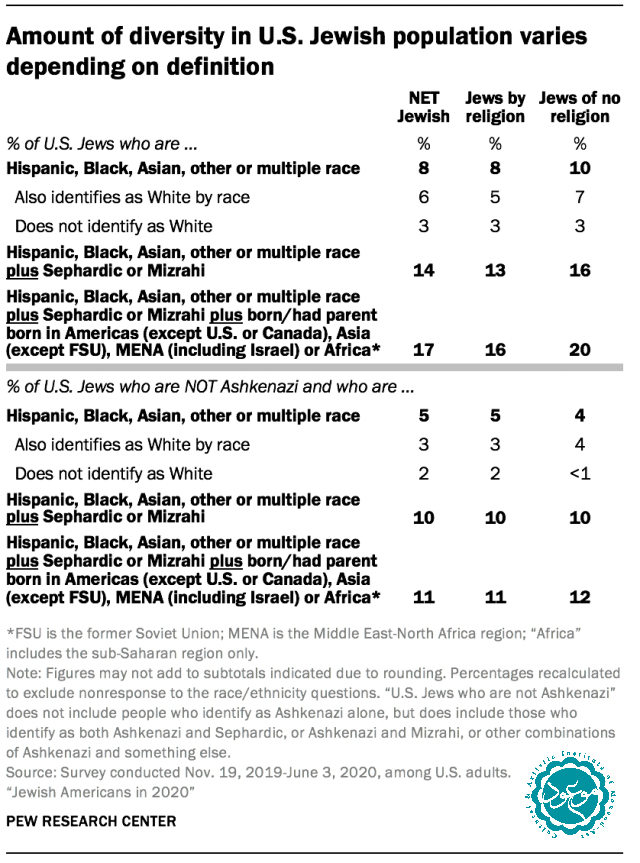
These overlapping categories of race and ethnicity, Jewish heritage and geographic origin can be combined to explore different definitions of diversity among U.S. Jews. Pew Research Center does not take a position on who should or should not be counted as Jews of color. But the accompanying table can provide a sense of how widely the number of people in that category – or in other categories, reflecting various kinds of diversity in the Jewish context – would vary depending on one’s definition on who counts as diverse.
For example, if one were to take the 8% of U.S. Jews who identify as Hispanic, Black, Asian, some other race or multiracial, and then subtract those who identify with the Ashkenazi majority, then the resulting group (approximating a non-White and non-European-background population) would total 5% of adult Jews.37 And if one were to look only at Jews who do not identify as White in any way – subtracting those who say they are White and Hispanic, for example – then this group is 3% of U.S. Jewish adults.
On the other hand, if one were to take the 8% who identify as Hispanic, Black, Asian, some other race or multiracial and then add White, non-Hispanic U.S. Jewish adults who identify as Sephardic or Mizrahi (or a combination of Ashkenazi, Sephardic and Mizrahi), the percentage rises to 14%. Or one could take an even broader definition of diversity in the U.S. Jewish population, trying to take into consideration the survey respondent’s race or ethnicity and Jewish heritage and country of origin. For example, if one were to count all Jewish adults who identify as Hispanic, Black, Asian, some other race or multiracial; plus those who consider themselves Sephardic or Mizrahi; plus those who were born outside the United States, Canada, Europe or the former Soviet Union, or have a parent born anywhere besides the U.S., Canada, Europe or the former Soviet Union, a combined total of 17% of U.S. Jews would fall into those categories.
Additional kinds of diversity, such as by sexual orientation, are discussed in Chapter 10.
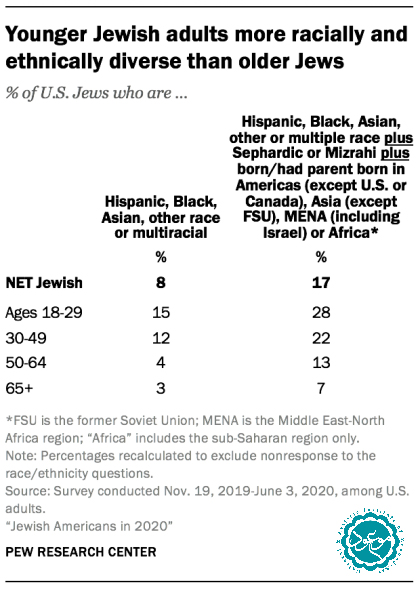
In time, the racial and ethnic profile of U.S. Jews may shift, since Jewish adults under the age of 50 are more likely than older Jews to identify as Hispanic, Black, Asian, another race or multiple races (13% vs. 3%).
Using the broadest definition of diversity offered as an example in this chapter, nearly three-in-ten Jewish adults under 30 (28%) identify as Hispanic, Black, Asian, other race or multiracial; identify as Sephardic and/or Mizrahi; or are immigrants or children of immigrants to the U.S. from outside Canada, Europe or the former Soviet Union – compared with a total of 7% of Jews ages 65 and older who meet any of those overlapping dimensions of diversity.
Racial and ethnic diversity in Jewish households
Unlike in 2013, the 2020 Pew Research Center survey asked respondents separately about the race and ethnicity of all adults and children living in their household.
Fully 13% of Jewish respondents report that they live in multiracial households, i.e., in multi-person households where at least one adult or child has a different race or ethnicity than the respondent.38 But most Jewish respondents (87%) either live alone or live in multi-person households where everyone shares the same racial and ethnic identity. This includes 83% who say everyone in their household – which may consist of a single adult – is White and non-Hispanic, along with 4% who say everyone in their household shares a racial or ethnic identity that is not non-Hispanic White.
Combining the 13% of respondents who live in multiracial households with the 4% who live in single-race, non-White households, the survey finds that 17% of U.S. Jewish adults live in a household where at least one person (adult or child) is Hispanic, Black, Asian, another race or multiracial.39
Compared with Jews by religion, Jews of no religion live in more racially diverse households. Roughly one-quarter of Jews of no religion (23%) say they live in a multi-person household in which at least one other adult or child has a different racial or ethnic identity, compared with 9% of Jews by religion who report that they live in multiracial households.
For an analysis of interracial/interethnic marriage among U.S. Jews, see Chapter 4.
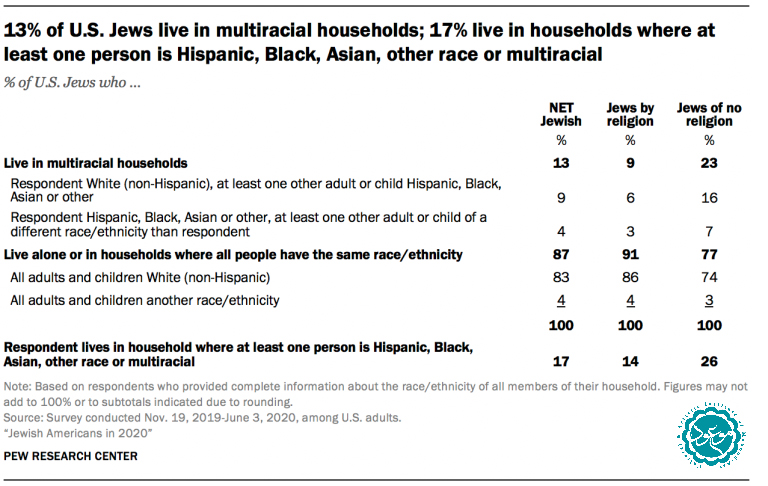
The survey makes it possible to see the degree of partial overlap between the racial and ethnic categories conventionally used in the United States and the heritage categories often used by Jews (Ashkenazi, Sephardic and Mizrahi). Those heritage categories are a matter of different customs and liturgies, not just ancestry or country of birth. Nearly two-thirds of U.S. Jewish adults say they are both non-Hispanic White and Ashkenazi (63%). Much smaller numbers identify as non-Hispanic White and Sephardic (2%) or non-Hispanic White and Mizrahi (less than 1%).
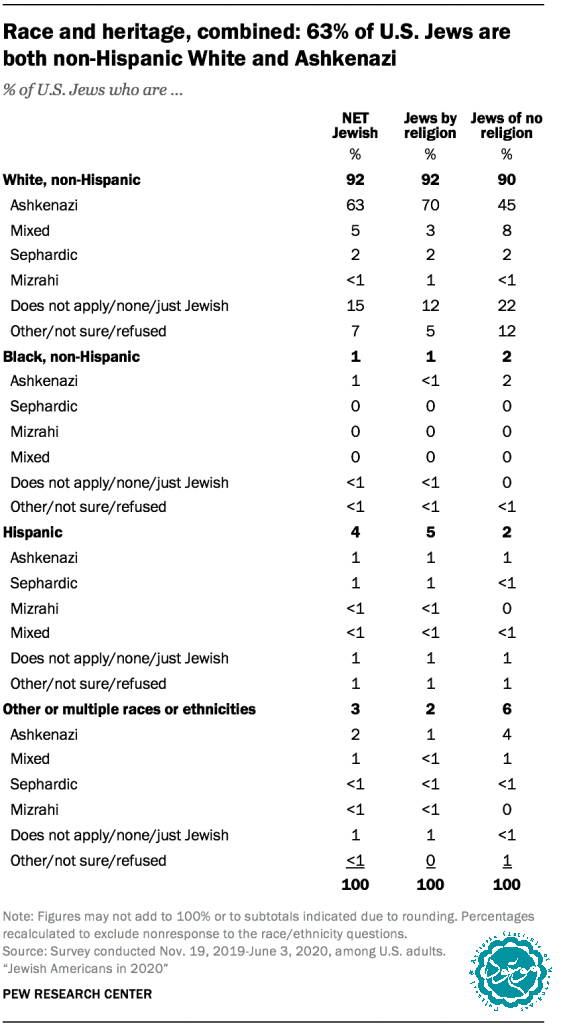
About 4% of U.S. Jews are Hispanic, including 1% who also say they are Ashkenazi and 1% who identify as Sephardic. About 1% of Jewish adults are non-Hispanic Black and Ashkenazi, though some Black respondents give other answers, such as that the heritage labels don’t apply to them or that they are “just Jewish.” And 3% of Jewish adults identify with other races or ethnicities (such as Asian) or are multiracial, including 2% who also say they are Ashkenazi.
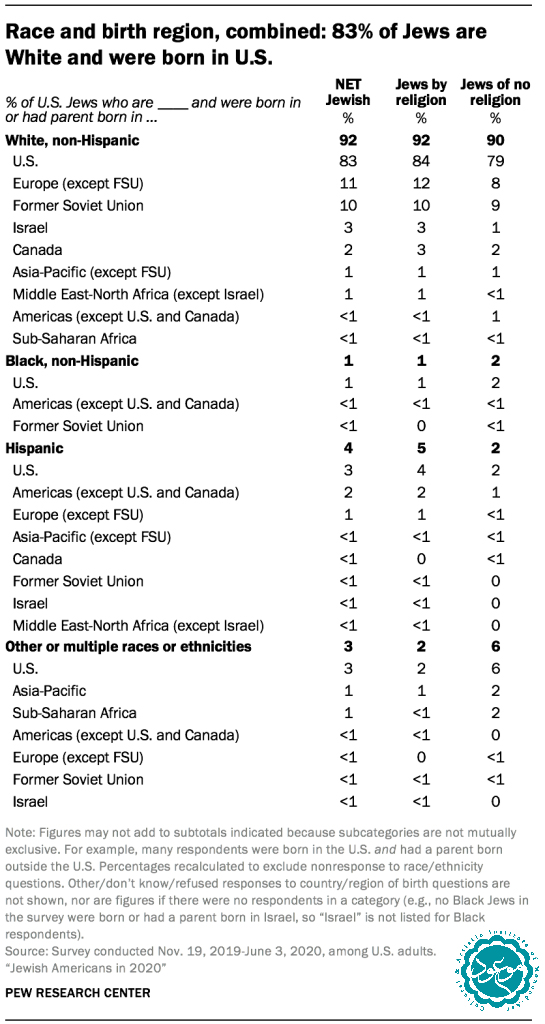
In terms of the overlap between race/ethnicity and region of birth, about one-in-ten of all U.S. Jewish adults are both non-Hispanic White and were born in the former Soviet Union or had a parent born there. A similar share (11%) are non-Hispanic White and were born, or had a parent born, elsewhere in Europe (outside of Russia, Ukraine, Belarus or other former Soviet republics), while 3% are non-Hispanic White and were born or had a parent born in Israel. Fewer than 1% identify as non-Hispanic White and say they were born, or had a parent who was born, in the Americas outside of the United States or Canada.
About 1% of Jewish adults are non-Hispanic Black and were born in the U.S.
Approximately 3% of Jewish adults are Hispanic and were born in the U.S. An additional 2% are Hispanic and were born or had a parent who was born in the Americas but in a country other than the U.S. or Canada.
Finally, when it comes to the overlap between Jewish heritage categories and countries of origin, the survey shows that six-in-ten U.S. Jews (60%) both identify as Ashkenazi and say they were born in the United States. An additional 9% identify as Ashkenazi and say they were born in Europe (excluding the former Soviet Union) or had a parent born there, and 7% were born, or had a parent born, in the former Soviet Union.
Overall, 3% of U.S. Jews say they are Sephardic, including 2% who were born in the U.S., 1% who were born or had a parent who was born in Europe, and fewer than 1% who were born or had a parent who was born in the Middle East-North Africa region.
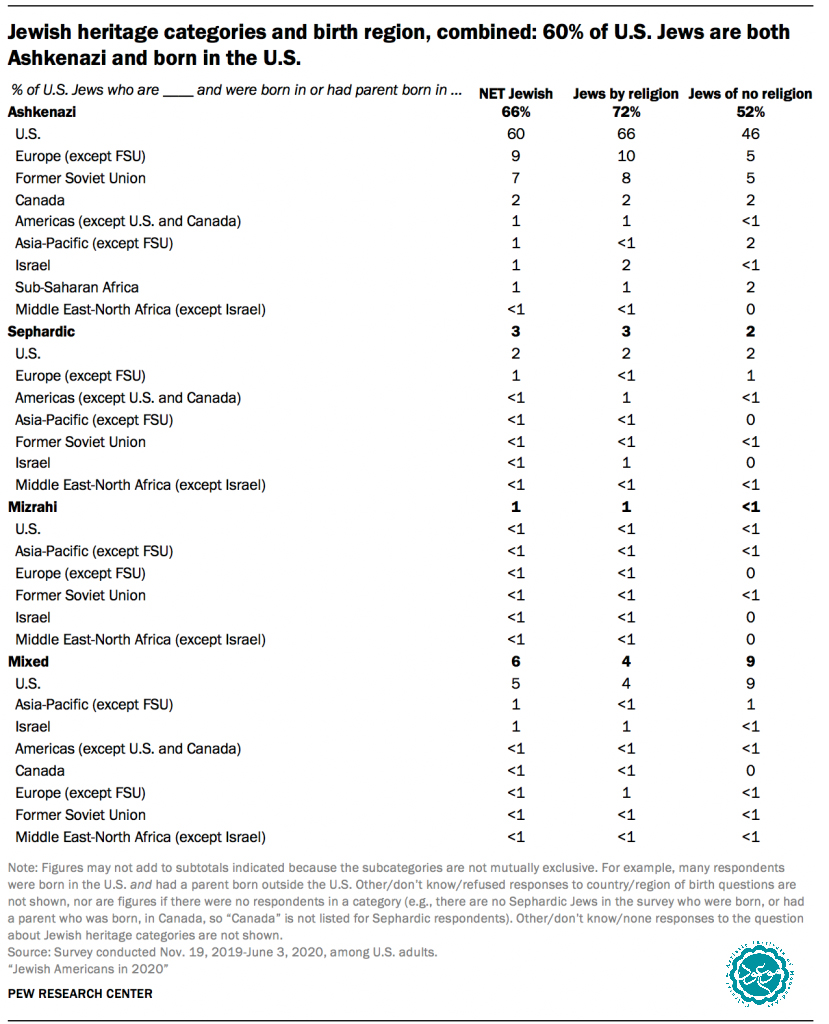
Sidebar: Jews of many racial and ethnic background
To provide another window into some of the changes occurring in American Jewish life, Pew Research Center conducted a series of in-depth interviews with rabbis and other Jewish leaders. These conversations were separate from the survey of U.S. Jews. Although the interviewees were not selected in a scientific manner, and hence are not representative of Jewish leaders overall, we sought a diversity of viewpoints and have tried to convey them impartially, without taking sides or promoting any positions, policies or outcomes.
In the 2020 Pew Research Center survey, 8% of U.S. Jewish adults identify as Hispanic, Black (non-Hispanic), some other single ethnicity or race other than White, or as multiracial. The majority (92%) identify as White (non-Hispanic). Age patterns in the survey data indicate that the percentage of Jews who do not identify as White may be growing, and about one-in-six U.S. Jews (17%) already live in households with at least one adult or child who is Black, Hispanic, some other non-White race or ethnicity or multiracial.
Yet, even with this rising diversity, Jews who identify as White and non-Hispanic continue to make up the majority of American Jews, and people of other backgrounds sometimes feel like outsiders at synagogues, community centers, summer camps and other Jewish organizations, according to Jewish community leaders, activists and rabbis who spoke with Pew Research Center in interviews conducted apart from the survey.
Rabbi Sandra Lawson, who in 2021 became the first director of racial diversity, equity and inclusion for Reconstructing Judaism – the central organization of the Reconstructionist Movement – said she has often been asked if she is Jewish while in synagogue even when she is wearing a tallit (prayer shawl). Lawson, who identifies as Black, said she once noticed a man looking at her during the Amidah prayer. “For religious folks, the Amidah is the prayer you don’t interrupt people praying. But he kept staring at me,” she said. “I turned and said, ‘What is the problem with you? Is my presence here bothering you?’”
Jared Jackson, executive director of a group called Jews in ALL Hues, said he hears stories every year about Black Jews being questioned by synagogue security personnel about their presence at High Holy Day services. “That’s been happening for a very long time,” he said. In his own life as a Black Jew, he added, there were times in his childhood when he was called racial slurs, both in English and in Yiddish, by other Jews. And while he thinks the situation has gotten better, racist behavior in the Jewish community “is not totally gone,” Jackson said. “It’s more covert than overt right now. People still go through it, honestly. That’s why my organization exists.”
Indeed, Jews in ALL Hues is one of several national organizations that have arisen to address issues of racial equity and diversity among U.S. Jews. Others include the Jews of Color Initiative and the Jewish Multiracial Network.40
The dominance of Ashkenazi heritage (associated with Central and Eastern Europe) in American Judaism can make Jews who don’t share that background feel out of place in synagogues and other Jewish settings, said Ilana Kaufman, executive director of the Jews of Color Initiative.
Several congregational rabbis who were interviewed for this report said they have become more attuned in recent years to the feelings and needs of people of color in their congregations. While most said their congregants are still predominantly White and Ashkenazi, they also said there is noticeably more diversity now than in previous decades, due to adoptions by Jewish families, marriages by Jews to non-Jews, adult conversions to Judaism, immigration from places outside of Europe and increased openness toward Jews of color at synagogues.
“People are finally waking up to the fact that our Jewish community is quite multicultural,” said Rabbi Angela Buchdahl of Central Synagogue in New York, a Reform congregation.
Buchdahl, who was the first Asian American to be ordained as a rabbi, said it is vital that people of color feel at home in synagogues across the country. “I think our community can still behave in a tribal sort of way, where there are a lot of assumptions – ‘You don’t look Jewish!’ – which I think many Jews don’t realize is off-putting to people of color. It makes them feel like a stranger in their own home, like they don’t really belong.”
Rabbi Sharon Brous of IKAR in Los Angeles said her congregation recently bolstered the diversity of its board of directors. Four of the five new board members are Jews of diverse racial or ethnic backgrounds, she said.
The board’s new makeup “is more reflective of what the reality is in the country,” she said. “We know that, historically, Jewish communal spaces have not felt welcoming for Jews of color too often. … We’ve worked hard to be a loving and just community, and we realized a few years ago that that’s just not enough. We have to actively work to create a space that will feel welcoming.”
Some other rabbis said their congregations aspire to be welcoming to all Jews, including intermarried couples and LGBT people as well as Jews of color, but they have not yet experienced much change in the racial or ethnic composition of their members.
“We have seen, over the years, changes in some ways,” said Rabbi Brigitte Rosenberg of United Hebrew Congregation in Chesterfield, Missouri, a suburb of St. Louis. “But the vast majority of our congregants are of Ashkenazi descent. … I really do believe it’s a function of our location.”
Buchdahl estimated that non-White Jews make up between 10% and 15% of the congregants at her New York synagogue. “Many are people of color who convert to Judaism,” she said. “I would say that being a rabbi of color – and I identify that way – I think has attracted people … who might not have otherwise come. I think increased sensitivity to issues around that has helped make them feel at home here.”
One challenge in assessing the diversity of Jewish congregations, some activists and scholars said, is whether the term “Jews of color” should be applied to people who may not think of themselves that way.
“The term ‘Jews of color’ has been used far and wide these days, and includes a lot of people for whom being a person of color was not part of their identity inside of the United States for the vast majority of their lives,” said Jackson, of Jews in ALL Hues, citing Jews from the Middle East as an example.
Mijal Bitton, a scholar in residence at the Shalom Hartman Institute of North America who is writing a book on Syrian Jews in the United States, sees “a growing gap between how mainstream Ashkenazi Jewish communal organizations think of Jews of color and how many ethnically and racially diverse Jews self-identify.”
Part of the issue, she said, is that the traditional Jewish heritage categories – Ashkenazi, Sephardic and Mizrahi – do not cleanly map onto U.S. categories of race and ethnicity: Being Ashkenazi doesn’t necessarily mean being White, and being Sephardic or Mizrahi doesn’t necessarily mean being a person of color.
“The idea that the Syrian Jews I’ve studied are ‘Jews of color’ would feel overwhelmingly foreign and even ludicrous to them,” Bitton said. “Some might identify as White, some as Middle Eastern, some as non-White – but not as Jews of color.”
Who is – or is not – a Jew of color is “not the right question” for Sephardic Jews in America, said Brigitte Dayan, an Orthodox Jew of French Moroccan ancestry in New York City. “The relevant question is: Do we see ourselves as occasional victims of discrimination in the organized Jewish world? I think the answer, for many of us, is ‘yes.’”
Others questioned how well the term “person of color” applies to Hispanic Jews of Ashkenazi heritage, such as people whose parents or grandparents were refugees from Europe to Latin America during or after World War II.
“Would you call a Latin American Jew who moved to the United States from Argentina or Mexico, and whose parents came from Poland or Germany, a Jew of color?” asked Judit Bokser Liwerant, a professor at the National Autonomous University of Mexico who researches Latin American Jews.
She said she doubted that such a person would self-identify as a person of color.
“The concept of Jews of color, though intended to foster inclusion, runs the risk of lumping together people who have singular trajectories into an undifferentiated ‘other,’” Liwerant said. She added that she thinks many Latin American Jews also would reject the “Hispanic” label, which “is formulated for the overall society” but is “historically and sociologically irrelevant when applied to the Jewish case.”
The 2020 survey did not ask respondents whether they consider themselves “Jews of color” or “people of color,” and Pew Research Center consequently does not have an estimate of the share of U.S. Jews who describe themselves in those ways. The 8% estimate in this survey is based on race and ethnicity categories designed to resemble the U.S. census, which the Center uses to weight its surveys to be representative of the U.S. adult population.
The survey also asked respondents, in a separate question, whether they consider themselves Ashkenazi, Sephardi, Mizrahi, some combination, or none of those categories. And it asked respondents about the countries where they were born and where their parents were born, allowing researchers to combine categories of race and ethnicity, Jewish heritage and country of origin in myriad possible ways.
However they identify racially, Jews of Middle Eastern descent bring cultural histories to American synagogues that are often unfamiliar to Ashkenazi Jews, according to two Ashkenazi rabbis. Rabbi David Wolpe of Sinai Temple in Los Angeles said that Iranian Americans now make up more than half of his Conservative congregation and have been a large presence there since the late 1970s, when many emigrated from Iran. At first, he said, differences between Iranian American Jews and Ashkenazi Jews – over food, language, and even attitudes toward sending children to sleepovers and summer camps – hindered efforts to bring the congregation together.
“It was tense among the two groups, but also there were constant appeals for unity and togetherness,” Wolpe said. “It’s much better now, but it took a long time and a lot of work.”
Rabbi Howard Stecker of Temple Israel in Great Neck, New York, also leads a Conservative synagogue with many Iranian Americans. For the Ashkenazi Jews in his congregation, mixing with Jews who are not descended from Europeans has been a learning experience, he said: “It has forced us to be more mindful of certain assumptions that we have about what it means to be Jewish.”
- One definitional complication is that the traditional Jewish categories of Ashkenazi, Sephardic and Mizrahi do not squarely align with racial and ethnic categories conventionally used in the United States. For example, some Hispanic Jews in the U.S. are of Ashkenazi background – descended from refugees who fled Europe for Latin America around the time of World War II – prompting advocates and scholars to debate whether all Hispanic Jews should be counted as Jews of color. On the other side of the ledger, although the Census Bureau historically has classified people of Middle Eastern background as White, organizations representing Jews of color contend that some immigrants from the Middle East-North Africa region and their descendants should be counted as Jews of color. For more discussion, see the sidebar “Jews of many racial and ethnic backgrounds” at the end of this chapter.
- For more on how the U.S. census measures race, see “The changing categories the U.S. census has used to measure race.” For more on how race is measured in survey research and the relationship to experiences of race, see Wallman, K.K., S. Evinger and S. Schechter. 2000. “Measuring our nation’s diversity: Developing a common language for data on race/ethnicity.” American Journal of Public Health. Saperstein, Aliya, Jessica M. Kizer, and Andrew M. Penner. 2015. “Making the Most of Multiple Measures: Disentangling the Effects of Different Dimensions of Race in Survey Research.” American Behavioral Scientist. Porter, Sonya R., and C. Matthew Snipp. 2018. “Measuring Hispanic Origin: Reflections on Hispanic Race Reporting.” The ANNALS of the American Academy of Political and Social Science. Luquis, Raffy R. 2010. “Categories for Race and Ethnicity—A Commentary.” American Journal of Health Education.
- Each of these traditional Jewish categories is associated with a set of customs that include different liturgies, foods, holiday observances, synagogue architectural styles, rabbinical lineages or schools, and other traditions. Some Jews may think of these categories as bloodlines, but the survey defined them as “following the Jewish customs of” particular regions, because people can migrate, marry into, or choose for other reasons to identify with these categories, regardless of ancestry. In many cases, the geographic connections are remote in time. Sephardim, for example, trace their customs to Spain before the expulsion of the Jews from that country in 1492.
- The survey asked about a parent’s country of birth only if the respondent was born in the United States. A parent’s birth country is unknown for respondents who say they were born outside the U.S.
- This calculation excludes respondents who identify solelyas Ashkenazi (and not a combination of Ashkenazi and Sephardic or Mizrahi).
- Respondents were asked to specify the race and ethnicity of their household members. Household members were not asked directly how they identify racially or ethnically.
- This person may or may not be the respondent. In cases where they are not the respondent, they may or may not be Jewish.
- Here is how these three organizations describe themselves on their websites: Jews in ALL Hues is “an education and advocacy organization that supports Jews of Color and multi-heritage Jews.” The Jews of Color Initiative is “a national effort focused on building and advancing the professional, organizational and communal field for Jews of Color.” The Jewish Multiracial Network “has worked to provide families with resources about diverse Jewish communities, facilitated dialogue on ways in which members can marry their cultural traditions with Jewish ritual, circulated information about books and movies that feature ethnically and racially diverse Jews, and created original materials that feature the diversity of the Jewish community.”
 Mouood Mouood English Edition
Mouood Mouood English Edition
